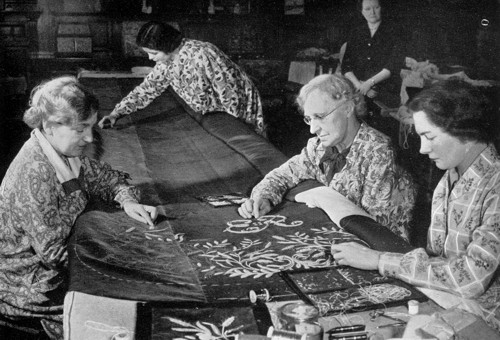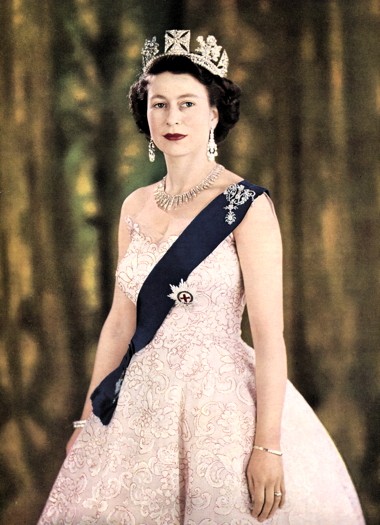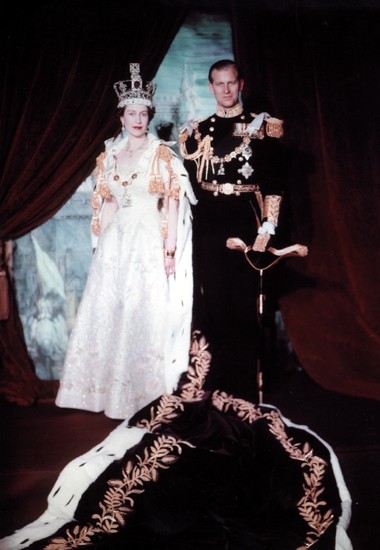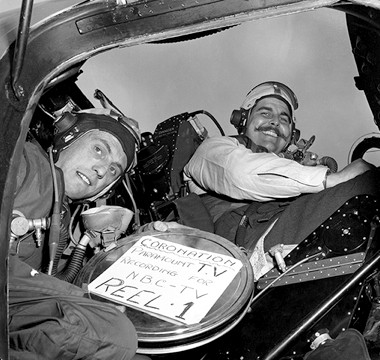Coronation Cosmetics
The Coronation of Queen Elizabeth II took place in Westminster Abbey on 2nd June, 1953. The event was broadcast by the BBC for black and white television and recorded on colour film. As an experiment, parts of the procession were also televised in colour but the transmission was only viewed publicly by the children and staff of the Hospital for Sick Children in Great Ormonde Street, London.
Planning for the event took over 16 months, so there was plenty of time to make sure that everything was in order, including the make-up the Queen and her Ladies-in-Waiting were to wear on the day. This was entrusted to Thelma Holland, the director of the London salon of Cyclax, an English cosmetic company founded in 1897. The Queen’s hair was dressed by her personal hairdresser, Mr. Jules Henri Joerin of the London firm Emile.
Thelma Holland and Cyclax
Thelma Holland, née Besant, was born in Melbourne. After receiving Cyclax training in London in 1934, she returned to Australia and travelled the country as a demonstrator for Cyclax before returning to London in 1940 to join the London salon in South Molton Street.
In 1943, Thelma approached Queen Elizabeth – later the Queen Mother – about providing cosmetic advice to the two young princesses, Elizabeth and Margaret Rose. When the Queen agreed, Thelma became the cosmetician and beauty adviser to the royal household and was entrusted with the royal complexion.
See also: Cyclax
The relationship between Queen Elizabeth II and Cyclax was a good fit. The ‘English rose look’ that Cyclax promoted suited Elizabeth’s skin colouring perfectly. With her dark brows, blue eyes and clear, creamy skin, she did not need to use a lot of make-up and generally limited herself to a powder base, a little face powder and a pink-toned lipstick.
Elizabeth follows the rule of understatement in makeup says Mrs. Holland—A safe rule for everyone. She has flawless skin and doesn’t need to plaster it with heavy foundation tints. In general she likes pinky tones in lipstick and cosmetics, having learned early on in life that pink is the most flattering tone for practically all women.
She does not go in for heavy eye makeup, since her lashes and brows are naturally dark and well shaped, and her blue eyes are one of her most attractive feature.(Milwaukee Sentinel, 1957, p. 38)
Coronation make-up
Six months of testing and preparation went into developing the Queen’s make-up for the Coronation. A number of considerations had to be taken into account when determining the make-up Elizabeth would wear on the day.
Elizabeth had to look her best for the crowds that lined the streets to see the state procession but also had to photograph well for black-and-white television and colour film. In addition, the make-up had to perform in three types of lighting: the artificial light of Westminster Abbey; the interior of the state coach; and instances of full daylight. As there was only one break in the ceremony – just before the Queen returned to the palace – the make-up also had to remain in place for up to four hours without retouching – the Abbey service alone ran for just over three hours – and for most of the day without being reapplied.
As well as Elizabeth’s preference for minimal make-up, there was another reason for keeping things simple. The Coronation was a religious event with one part, the anointing, considered so sacrosanct that it was not filmed or broadcast. Given this, the Queen considered that make-up should be kept to the minimum required for broadcasting and filming.
The Queen’s feeling is that the Coronation is a deeply religious ceremony. She wants to be herself … None of this movie star stuff — although she appreciates that some special touches are necessary for photographic purposes.
(St. Petersburg Times, Florida, June 2, 1953, p. 30)
This simplicity also extended to Elizabeth’s hair style. Mr. Henri Joerin, the royal hairdresser from 1939-1969, believed that “simplicity and good taste should be the keynote of all good hairdressing” (Sydney Morning Herald, 1953, p. 9). It was a good policy as it meant that official photographs of the Queen would be less likely to date. It also suited the Coronation requirement that the Queen’s hair be set to accomodate the two different crowns she would wear during the ceremony – the St. Edward’s Crown and the Imperial State Crown – as well as the ‘Diamond Diadem’ she wore from the Palace to the Abbey.
Considering the length of the ceremony and the state processions before and after the service, it was agreed that Elizabeth would wear a liquid foundation as it would last longer than a cream. Given the Cyclax range at the time this would suggest that the Queen used Cyclax GlamOtint covered with a light dusting of Cyclax powder.
Colour
As well as the considerations of skin tone, lighting and film type, the colours used in Elizabeth’s make-up had to tone with the Coronation regalia, some of which – like the Robe of State – were a rich red.

Above: 1953 Embroidering the Queen’s Robe of State. It was 5.5 metres (6 yards) long, made from pure silk and gold thread embroidered by the Royal School of Needlework, Kensington. The velvet used in the robe was hand-woven from silk grown on an English silk-farm situated in Lullingstone Castle, Kent. Silk from the farm had previously been used in the Coronation robes of George VI in 1937, and in the train of Elizabeth’s wedding dress in 1947. The Kentish farm would later go on to make silk for Lady Diana’s wedding veil in 1981.
Taking into account the colours of the assorted Hartnell designed gowns that Elizabeth wore and her natural skin tone, it was decided to use a peach-tinted, liquid foundation with a lipstick described either as ‘pink to red’ or as a ‘deep, ruby red with soft undertones’. After the Coronation, Cyclax released a make-up range ‘designed for the Coronation year’ — ‘Pink Velvet’ GlamOtint Foundation, ‘Pink Velvet’ Powder, ‘Crown Jewel’ Lipstick and ‘Crown Jewel’ Rouge.
Elizabeth’s maids of honour were also assisted with their make-up. Some had their eyebrows darkened and all wore lipstick to ensure they looked their best when filmed.
Looking at photographs of the event it is clear that the Queen and Thelma Holland chose well. The Cyclax make-up held up for the entire ceremony and the Queen looked radiant for the whole day.
First Posted: 22nd December 2014
Last Update: 26th December 2018
Sources
Arlott, J., Snagge, J., & Wollaston, G. W. (1953). Elizabeth crowned Queen. The pictorial record of the Coronation. Sydney: Daily Telegraph.
Elizabeth will wear little makeup, but this must last for many hours. (1953, June 2). St. Petersburg Times, Florida, p. 30.
Follow the Queen’s beauty tips, beauty expert says. (1957, August 21). The Milwaukee Sentinel, p. 38.
The Queen. The Coronation. 1953. (1953). London: Keliher, Hudson & Kearns, Limited.
Queen Elizabeth to get proper lipstick shade. (1953, May 28). Evening News, p. 7.
Queen’s hairdresser is in the Gothic. (1953, December 3). Sydney Morning Herald, p 9.
Queen’s lipstick important factor in Coronation plans. (1953, May 27). The Progress-Index, p. 22.
Too much adornment mars attractiveness. (1957, July 7). The Kansas City Times, p. 57.

1953 Queen Elizabeth II with the George IV State Diadem or ‘Diamond Diadem’ on her head. She does not seem to be wearing any eye make-up.

1953 Queen Elizabeth II and Prince Philip, Duke of Edinburgh. The Queen is wearing the Imperial State Crown and Robe of State but the photograph does not reflect its true colour.

The first newsreel of the Coronation sets off for North America. Others would follow.

c.1945 Dorothy Thelma Helen Holland, née Besant [1910-1995]. Born in Melbourne, Australia. In 1943, she married Vyvyan Holland [1886-1967] the younger son of Oscar Wilde.

1953 Cyclax GlamOtint, Cyclax Face Powder and Cyclax ‘Crown Jewel’ Lipstick.

1953 Spectators forming along the Coronation procession route.

1953 The Queen arriving at Westminster Abbey wearing the gown designed by Hartnell and the Robe of State carried by six Ladies-in-Waiting.
